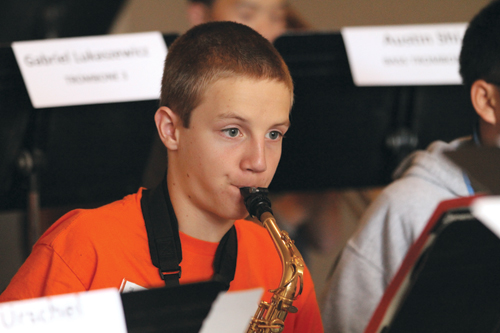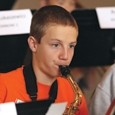
Editor’s note: The following link is to a YouTube playlist that includes the musicians and tunes mentioned in this article: http://tinyurl.com/leadalto1
A fine saxophone section is a hallmark of any successful big band, and the key to the success of any saxophone section is the lead alto. The lead alto player is what gives the saxophone section its distinctive sound. Here are some concepts that have helped me greatly as a lead alto player and methods I use with my students.
Sound
The first thing that any young saxophonist must work on is getting a beautiful and characteristic lead alto sound. Such a sound is effervescent – bright and glowing with a warm depth and fullness.
Sound Concept
There are three essentials to a great lead alto sound. The first is focused listening. To achieve a great lead alto sound, a student must first have a great tonal concept, which will only come from listening to as many of the great lead alto saxophonists as they can. Some of my favorites are Johnny Hodges of the Duke Ellington Orchestra, Marshal Royal of the Count Basie Orchestra, Jerry Dodgion/Jerome Richardson of the Thad Jones/Mel Lewis Orchestra, Dick Oatts of the Vanguard Jazz Orchestra, and Brad Leali of the Harry Connick, Jr. Orchestra. Each lead alto player gives the saxophone section a specific musical personality that correlates with the style of the band; the student should listen for the stylistic character of every lead alto saxophonist and how they differ, then ponder what about each saxophonist’s playing makes them a great lead alto saxophonist. Part of playing a historical composition is understanding and playing in the style of the original band’s lead alto player.
Luck be a Lady (Count Basie Orchestra)
In this example of the Basie band with Frank Sinatra, Marshal Royal immediately establishes the singing sound and vibrato for which he and the Count Basie saxophone section are known. He plays the opening phrases to complement Sinatra’s vocal style and the result is a beautiful duet. Throughout this example, with his expressive clarity, Marshal leads the saxophone section to a swinging and vocal interpretation of this tune.
Cottontail (Duke Ellington and His Orchestra)
The Ellington saxophone sound established by Johnny Hodges has a faster vibrato than the Basie saxophone section. In addition, the tone color is a little bit warmer and more orchestral. During the famous saxophone soli about two minutes in, Hodges’s warm but cutting sound is clear. He articulates the short notes and is supported by the warmth of the Ellington saxophone section. The eighth notes in the Ellington style are bouncier and on top of the beat in this example.
Mean What You Say (Vanguard Jazz Orchestra)
In this modern example, Dick Oatts effectively balances the unisons with the soli sections of this beautiful composition by Thad Jones. The band comes in after the initial piano solo at about 2:15, and at 2:38, you will hear Dick Oatts pop out of the unison texture for a brief and exclamatory saxophone response to the melodic statement. At 2:50, Oatts seamlessly takes over for the saxophone soli section and leads the brief melodic section with his powerful sound and singing phrasing.
Sound Production
Another aspect of obtaining a great lead alto sound is the physical production of the sound. Students rarely realize how the specific fundamentals to getting a great lead alto sound and may differ from getting a great classical saxophone sound. Here are some fundamental exercises that will get students sounding great.
The first fundamental area is air support. In general, jazz saxophone playing takes a fast, warm, direct airstream. When playing lead alto, I think of projecting and focusing my airstream to a small point across the room. I often have the students play a comfortable long note (usually C5 or D5) and practice playing with this kind of air. The student should take in a full breath and feel the engagement of the abdominal muscles throughout the exhalation and resulting pitch.
The second subject to address is outer embouchure. When teaching high school students, the best approach is to start with a good classical embouchure in which the chin is flat and the corners are brought in diagonally. There can be a wide degree of variation from this; Charlie Parker’s embouchure is vastly different from those of John Coltrane and Sonny Rollins. Although there is no one jazz embouchure style that works for every musician, the embouchure muscles should always be relaxed with no excess vertical pressure. This will allow the reed to vibrate and produce the necessary edge in the jazz sound.
One of the more important aspects of the jazz embouchure is the relaxation of the lower lip. A great way to check this and simultaneously provide an excellent lesson in air support is to have the student play without using the top lip. This can be done one of two ways. First, you can simply retract the top lip over the top teeth. If this is difficult, the student can play notes that only require one hand, using the right hand to hold the upper lip away from the mouthpiece. The goal of this exercise is to make the sound as close to the sound when using the top lip as possible. Students will notice that producing the same sound takes much more air, which must be focused into the mouthpiece. They will also find that the pitches will not speak unless the lower lip is relaxed. If I notice that my air support, projection, or fullness of sound is lacking, this is one of my go-to exercises to get it back; five to ten minutes of this at the beginning of my practice session is all it takes. One caution is that because this will require more air than students may be used to, lightheadedness may occur. Student should sit down and take a break if necessary.
The third area to address is the inner embouchure. This is referred to as voicing – the control of the tongue and the throat muscles to shape the sound. I often explain voicing to students as the way to help the musculature of the body respond to what the ears hear. Voicing improves tone quality, intonation, projection, and control. Once a firm sound concept has been established in a student’s mind, voicing is the enabler that helps the student to control the airstream and produce the tonal concept.
One of my favorite voicing warmups is the first thing I do every day when I practice. I play on the mouthpiece alone and bend the pitch with the throat and back of the tongue. The pitch to start on for alto saxophonists is a concert A5. I have found that many students playing the mouthpiece overshoot and get a C6, so the first project is to lower the C (usually produced by excessive vertical pressure in the embouchure, too little air support, a tongue position that is too high, or a combination of the above) to an A. Once the A is obtained, the student should bend the A down in intervals increasing by a half step (as a Remington exercise), returning to the A each time. I like to have my metronome at 60 beats per minute and use long note values to bend the pitch, holding the destination pitch for four beats.
The sound on the mouthpiece should be full and focused, just as one would expect it to be when the entire saxophone is assembled. Frequently a lack of air support and too much pressure in the embouchure will lead to squeaking or an airy sound on the mouthpiece. My rule of thumb is that if one can hear air instead of tone, the solution is to use more air and move it faster. Once a student is able to do this, the sound will expand when the mouthpiece is placed back on the instrument. For classical saxophone, I like to set the inner embouchure so that the mouthpiece would sound around an A5, but for jazz I find that my voicing is around the F or an E below that. Everyone is different, so this may not be your result, but it should be in this area. As always, a discerning ear should be your guide.
Equipment
Another helpful component in getting a great sound is the right equipment. The mouthpiece, reed, and ligature must all work together in harmony, although the same setup may not work for everyone. For lead alto, it is important to obtain a high-quality setup that allows the player to project with ease and balances the tonal brightness that is required with enough depth and richness that the sound does not become shrill. For me, this means a medium-open to open mouthpiece and a medium to medium-soft reed. My best suggestion would be to try as many different combinations of reeds and mouthpieces as possible and find something that works for you.
Leading the Section
Sightreading
The lead alto saxophonist should be a strong sightreader, meaning that he should be able to establish a musical presence while sightreading. Reading the correct notes is just the beginning. The lead alto saxophonist sets the phrasing and must be able to make snap judgements on how to play a phrase. From the first time a passage is read, the lead alto player must set up the vibe of the tune that is being played and immediately establish a way to phrase the musical line.
The best way to improve reading is to practice it every day. It is ideal to practice reading as slowly as it takes to play the music perfectly and with great stylistic command of the melodic line. The student should look ahead in the passage and anticipate musical decisions that must be made before they actually arrive. Some materials that I enjoy using are Lennie Niehaus’s Jazz Conception for Saxophone series as well as Greg Fishman’s series of Jazz Saxophone Etudes and his Jazz Phrasing for Saxophone series. These books have helped my students to become better readers and are great examples of jazz lines that students will see in their big band music.
Lead Alto Rules of Thumb
One of the most important aspects of playing lead alto is confidence; the student must be confident and assertive with his performance of every line. This confidence often leads to clarity and is one of the things that helps the time lock in with the rest of the section and the rhythm section.
The lead alto should play melodic and soli passages with the singing quality of a soloist. The lead line should sparkle with emotion and a solid time feel. By this I mean that the phrasing of the line must be projected such that it is clear to the baritone saxophonist and lead tenor, who are the voices farthest from the lead alto player. When I play lead alto, I always try to play the dynamics, articulations, and phrasing more clearly than I think I need to. This will sound exaggerated if I am playing on my own, but with the section, this is necessary. Learning what it really means to project their sound and phrasing is one of the biggest struggles that my students have with playing lead alto.
For solid time, the lead alto saxophonist should always be listening to and locking in with the bass player’s quarter notes. While it is important to lock into the drummer’s ride cymbal, it is more important to lock into the bass player’s time. A great analogy is that the big band is a bus; the drummer is the driver, but the bass player is the engine.
A rehearsal technique that is particularly helpful for saxophone solis is having just two voices (the lead alto player and another voice) play at a time. Doing this makes it easier for students to hear if they are matching the lead alto player. Although breaking it down this way can be time-consuming, it is always time well spent and leads to a more unified section sound and interpretation.
In a concerted tutti section, where the full band is playing the same rhythm in harmony, the lead alto player should listen to and match the phrasing of the lead trumpet. The lead alto player need not play too loudly in these situations and should not try to overplay the lead trumpet player. Rather, the lead alto player should blend into the voicing of the band and support the lead trumpet player with clear and decisive articulation.
Whenever the saxophones are in unison, the lead alto player should play softer and blend into the sound of the tenor and baritone saxophones. The lead alto player should still be heard, but the dominating sound should be the tenor and baritone voices with the alto saxophones being only a tone color in this situation. A great example of this is the Count Basie Orchestra playing Sammy Nestico’s Wind Machine. In the unison saxophone melody that follows the piano solo, the altos blend into the sound of the tenor saxophones and the resulting sound is strong and cohesive. If the altos do not do this, they can cause intonation problems, and the section will not blend well.
As part of their listening studies, students should find recordings of great lead alto players playing their music. If the student is playing Frank Foster’s Shiny Stockings, then he should get the recording of the Count Basie Orchestra playing the tune and listen intently, marking Marshal Royal’s articulations and inflections in the part. The student should play along with the recording to learn the phrasing and interpretation of famous lead alto players. I have included a list of famous big bands and their lead alto saxophonists below. Chip Stephens, one of my professors at the University of Illinois, always tells us that “what’s on that page isn’t jazz.” By marking the part and playing with the recording, the student will learn all of the expressive and interpretive elements that make the music leap off the page – the things that make the music jazz.
The lead alto player is only one person in the band, but a great lead player can make the difference between a band that swings and a band in which the saxophone section sounds confused and directionless. The lead alto saxophonist gives the saxophone section a sparkling personality, and with the right guidance, an effective student can elevate the level of the saxophone section and the band. Students should listen intently and apply what they learn to confidently lead the saxophone section. Other students will respond to this kind of confidence and play more confidently themselves.
Suggested Listening
Marshall Royal, Count Basie Orchestra
Johnny Hodges and Otto Hardwick, Duke Ellington Orchestra
Jerry Dodgion and Jerome Richardson, Thad Jones/Mel Lewis Orchestra
Dick Oatts, Vanguard Jazz Orchestra
Steve Wilson, Maria Schneider Orchestra
Brad Leali, Harry Connick, Jr. Orchestra
Lennie Niehaus, Art Pepper, and Charlie Mariano, Stan Kenton Orchestra
Gary Foster and Toshiko Akiyoshi, Lew Tabackin Jazz Orchestra
Benny Carter, Fletcher Henderson Orchestra
Sharel Cassity and Jon Irabagon, Fat Cat Big Band






